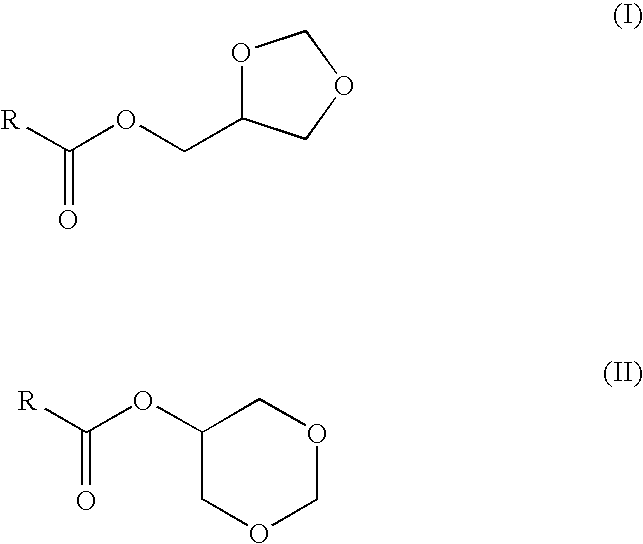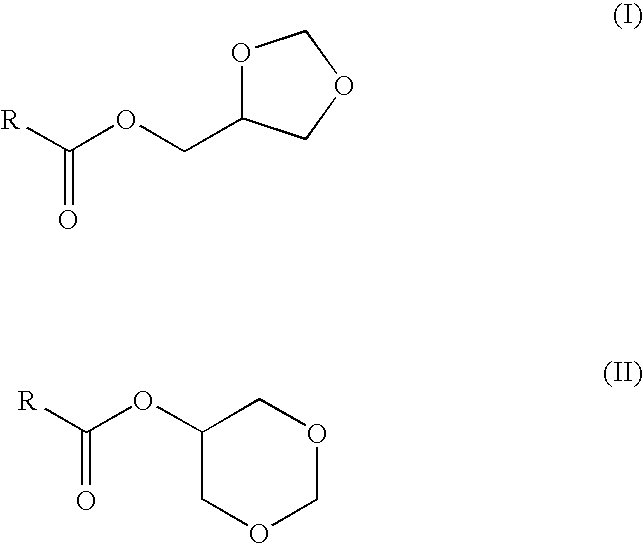Preparation of fatty acid esters of glycerol formal and its use as biofuel
a technology of glycerol and esters, which is applied in the field of biodiesel, can solve the problems of negative influence and inability to evaluate, and achieve the effect of improving the number of cetane and high glycerol conten
- Summary
- Abstract
- Description
- Claims
- Application Information
AI Technical Summary
Benefits of technology
Problems solved by technology
Method used
Image
Examples
example 1
Preparation of Glycerol Formal Esters from Fatty Acid by Transesterification of Rapeseed Oil with Glycerol Formal
[0030]A glycerol formal solution (3557.4 g, 34.2 mol) and sodium hydroxide (14.3 g, 0.21 mol) are added to rapeseed oil (262.5 g, 0.28 mmol). The mixture is heated up to 70° C. and stirred at 250 rpm for 16 hours. Subsequently, the mixture is cooled down to 30° C. and water was added to the crude reaction until the total separation of the two layers. The polar layer was neutralised to pH 7 and the excess of glycerol formal is distilled at reduced pressure to be recycled. The fraction which is not distilled and which contains free glycerol is reacted with formaldehyde in the presence of an acid catalyst to regenerated the glycerol formal. The apolar layer (the upper layer), which contains glycerol formal ester, is separated and washed with an aqueous solution of H2SO4 5% (312.3 ml). After that, the organic layer is washed with water until the pH is 7. The product is dried ...
example 2
Preparation of Mixtures of Fatty Acid Esters / Glycerol Formal and Miscibility Evaluation
[0031]The miscibility of glycerol formal when mixed with a biodiesel fuel derived from rapeseed, sunflower or palm oil in a 20% proportion (w / w) are compared in Table 2 for two different temperatures.
TABLE 2Miscibility of the mixtures biofuel / glycerol formal (80 / 20)BiofuelTemperature (° C.)MiscibleGlycerol formal esters of0Yesrapeseed oil fatty acid.20yesMethyl ester of fatty acid0Noof rapeseed oil.20NoMethyl ester of fatty acid0Noof sunflower oil.20NoMethyl ester of fatty acid0Solidify at 17° C.of palm oil.20No
example 3
Preparation of Mixtures of Methyl Fatty Ester / Glycerol Formal / Glycerol Formal Ester of Fatty Acid of Rapeseed Oil and Evaluation of the Miscibility
[0032]The miscibility of the ternary mixture biodiesel / glycerol formal / glycerol formal ester has been evaluated with different sources of fatty acids at different temperatures. The results are outlined on Table 3.
TABLE 3Miscibility of the mixtures biodiesel / glycerol formal / glycerolformal from rapeseed oil fatty acid.Glycerolformal esterof the fattyMethylGlycerolacidFatty acidfatty esterFormal(rapeseed)MiscibleNature%%%0° C.20° C.Rapeseed491239SISISunflower481240SISIPalm73207SolidSI
PUM
| Property | Measurement | Unit |
|---|---|---|
| pH | aaaaa | aaaaa |
| temperatures | aaaaa | aaaaa |
| miscibility | aaaaa | aaaaa |
Abstract
Description
Claims
Application Information
 Login to View More
Login to View More - R&D
- Intellectual Property
- Life Sciences
- Materials
- Tech Scout
- Unparalleled Data Quality
- Higher Quality Content
- 60% Fewer Hallucinations
Browse by: Latest US Patents, China's latest patents, Technical Efficacy Thesaurus, Application Domain, Technology Topic, Popular Technical Reports.
© 2025 PatSnap. All rights reserved.Legal|Privacy policy|Modern Slavery Act Transparency Statement|Sitemap|About US| Contact US: help@patsnap.com


